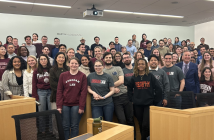Two of the nation’s most eminent female judges shared their wisdom on the judiciary and legal profession on April 17, in a conversation held at Fordham Law School.
Sandra Day O’Connor, former associate justice of the Supreme Court of the United States, and Judith S. Kaye, former chief judge of the New York Court of Appeals, weighed in on everything from the integrity of appointed vs. elected judges, to women in the law.
(continued below)
 |
| Barrier Breakers; Sandra Day O’Connor, left, and Judith Kaye, right, spoke at Fordham Law School. O’Connor was the first woman to sit on the U.S. Supreme Court; Kaye was the first woman to be named chief judge in New York state. Photo by Chris Taggart |
The hourlong conversation was moderated by John D. Feerick, LAW ’61, the Sydney C. Norris Professor of Law, whose own work on judicial selection in New York state served as a point of departure for a discussion of a legal conundrum: does appointing, rather than electing, judges make for a less corrupt judiciary?
Feerick chaired a 2006 report by the state’s Commission to Promote Public Confidence in Judicial Elections, offering reforms for judicial elections in the areas of candidate selection, campaign conduct and campaign finance.
But, as a judge who has “been in the trenches and seen it up close,” O’Connor, who ran for a judgeship in her home state of Arizona, called any electoral judicial system “a very poor way to pick judges.”
“An election that involves campaign contributions and money flowing into the courtroom? I cannot believe that is an equivalent to an appointive system,” said O’Connor, who retired from the Supreme Court in 2006 after more than 25 years on the bench. “No other nation in the world elects its judges.”
Kaye, who set up the commission, and who served on one of New York state’s few appointed courts – the Court of Appeals—expressed confidence in the commission’s recommendations to improve the judicial election process.
But she said she is not “proud” of what is happening elsewhere.
“In other parts of the country, 31 percent of high courts are elected,” she said. “I see millions of dollars being poured into those campaigns and I am worried.”
One answer to improving accountability in the nation’s judiciary, said the speakers, was to educate the public. Today, one-third of the people in the country don’t know that there are three branches of government, said Feerick.
O’Connor said that half of the states in the nation no longer require public schools to teach a course in civics. To offset this trend, O’Connor has started iCivics.org, a non-profit educational website that helps students to understand their branches of government, and the responsibilities attached to being a citizen.
Both women were judicial pioneers: O’Connor became the first female Supreme Court justice in 1980, breaking ground for the subsequent appointments of Ruth Bader Ginsburg, Sonia Sotomayor and Elena Kagan. Kaye was New York’s first female chief judge.
Although women make up roughly half of the nation’s law students, said Kaye, there is still unequal representation at the senior levels of the legal and judicial institutions.
“We need to keep our attention focused on . . .the woeful rise of women in the legal profession,” she said.
Fielding audience questions, O’Connor judiciously sidestepped commenting on the most conspicuous case currently before the Supreme Court: the legality of President Obama’s Affordable Care Act.
“I didn’t read the briefs,” said O’Connor. “I don’t even think the people who passed it read the legislation.”
The event was part of the Robert L. Levine Distinguished Lecture series, ongoing since 1992 and endowed by the Levine family in memory of Robert L. Levine (LAW ’26).


